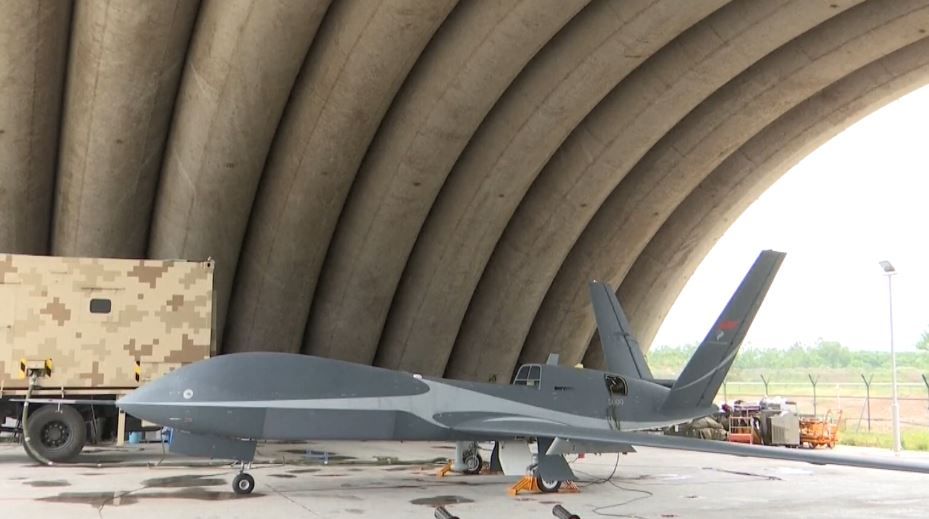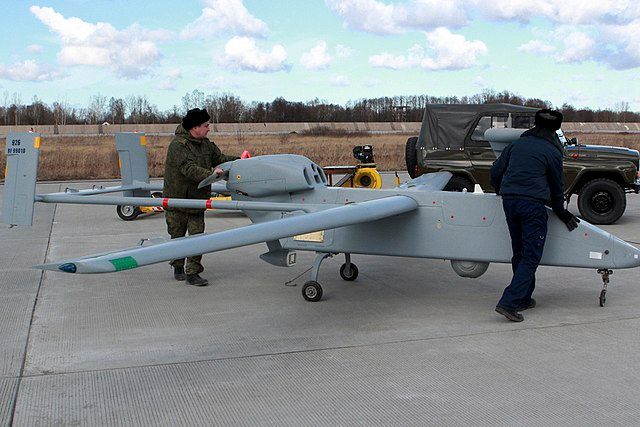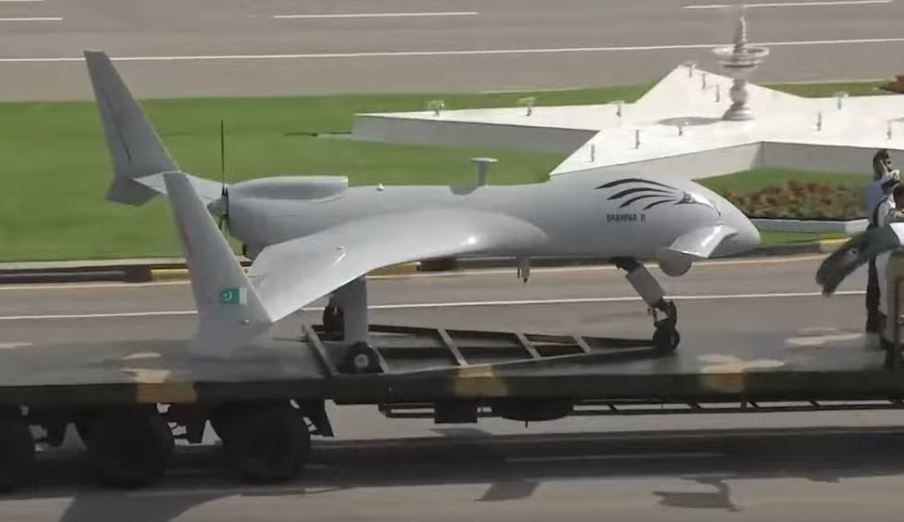Advanced Drones: AVIC Cloud Shadow, UZGA AO Forpost, GIDS Shahpar II
Advanced Drones: AVIC Cloud Shadow, UZGA AO Forpost, GIDS Shahpar II

High-altitude, Jet-powered AVIC Cloud Shadow
It is no longer surprising that Chinese aerospace manufacturers offer some of the most advanced combat drones ever built. Freed from export controls and transparency, there are almost no obstacles for countries around the world to increase their airpower by acquiring UAVs like the Cloud Shadow. Since it was first exhibited at a Middle East arms fair in 2017, this particular model represents the latest in its class of versatile jet combat drones.
Product information from AVIC and Chinese media reveals that the Cloud Shadow is a high-altitude combat drone with a ceiling of up to 46,000 feet (46,000 feet); it easily outperforms most fixed-wing drones in these criteria. However, it is better to expect the Cloud Shadow to operate at lower altitudes on real missions rather than the inflated numbers advertised by its manufacturer. Another important detail to keep in mind is its reliance on an as-yet-unidentified turbojet engine, limiting its endurance to a fraction of other combat drones that rely on propeller-driven turbo diesel engines. However, that may not be the case since the Chinese government adapted Cloud Shadows into "Wing Loong 10" from 2020 to perform flights designed to collect data on typhoons and other atmospheric events. Engine modifications to the Wing Loong 10 have been introduced since 2021, and it is worth considering how this changes its performance as an intelligence and surveillance platform.
As a combat drone, the performance characteristics of the Cloud Shadow are its best selling points. The flight range is over 2,000 kilometers and its payload reaches 1,900 pounds, which its capsule covers with the optics and various cannons it carries under each wing. Cloud Shadow's curved wings have hardpoints for three small-diameter rockets or bombs each. The exact type in both categories is determined by the end user, who can choose from various Chinese manufacturers. Automatic takeoff and landing are a given and Cloud Shadows can be used on even the most rudimentary airfields. Sold in sets of three with a ground control station, ideal end users of the Cloud Shadow are government or military personnel who need resources to gather information on land or sea, day or night, under any circumstances. any climate. As an attack aircraft model, it represents an attractive replacement for older ground attack fighter aircraft.
The Cloud Shadow's status with the PLA and its various branches is unclear as many other drone models enter service. Trying to draw comparisons between it and a similar US combat drone isn't very helpful. For example, the GA-ASI Predator C Avenger has a heavier and larger airframe and qualifies in a different class. Given the Avenger's flight ceiling, payload, and mission duration, no Chinese-made drone beats it unless deploying high-altitude models like the WJ-700 or the WZ-7 – this latter model is best gutted against the Global Hawk. There are so many different Chinese jet fighter drones available for export that it is amazing how many end users have not found.
UZGA AO Forpost, twin-boom combat drone

As the Russian military continues to wage war on Ukraine, its "intelligence operations" continue to work hard to influence perceptions of the ongoing hostilities. This is done in a number of ways, and some of the more benign include airing footage edited by surveillance drones as evidence that Ukrainian casualties are mounting. New video clips, often less than a minute long, are uploaded to encrypted P2P apps every other day and shared virally by anonymous accounts. The military in particular is very enthusiastic about its most powerful drone - the Forpost-R.
As of late 2021, the Forpost, originally the Israeli-made Searcher Mk II, is the latest evidence that the military has its own munitions-capable combat drones. Their need is all the more urgent as Russia's adversaries acquire the Turkish-made Bayraktar TB2 and use them to destroy large quantities of Russian-supplied weapons and equipment in smaller, localized wars. In the weeks leading up to the February 24 invasion of Ukraine, even the Russian Defense Ministry continued to push the idea that its Forpost-R and Orion-E drones carried missiles under their wings.
The truth is less exciting. On March 21, a large shopping center on the outskirts of kyiv was nearly destroyed by an Iskander-M ballistic missile. It turned out that the images before and after the attack were aimed at data collected by a Forpost drone and transmitted to an SRBM unit in neighboring Belarus. This is consistent with the model's original role as an artillery scout and charge against Ukrainian air defenses around their capital. (The Ukrainian military uses the same tactic, but with commercial quadrocopters.) While the attack on the Retroville mall was highly destructive, measuring the Forpost's effectiveness in precision strikes with small bombs is subject to debate. debate.
It has been a whole decade since Russia took over the Forpost and its ongoing assembly in a state-owned company called UZGA, AO. In a bygone era when they had unlimited access to promised NATO technology, the Russian Armed Forces chose the IAI Searcher Mk II. The Searcher series twin-boom drones were once the best-selling twin-boom drones for export in the late 1990s and 2000s. After the all-too-brief war against the Republic of Georgia in 2008, the Russian Ministry of Defense planned the institutional reforms that would make the armed forces world-class.
So, between 2008 and 2014, the Russians found a willing partner who could supply them with mid-altitude drones, until Russia's own aerospace industry caught up with a viable alternative. The Searcher Mk II had strong performance characteristics with a flight range of 500 kilometers and a mission duration of 20 hours. However, by today's standards, the Searcher Mk II lags behind other MALE drones because its maximum altitude ranges between 15,000 feet and 20,000 feet. But these met the needs of the military at the time, and even as Moscow and Tel Aviv fought each other during the Syrian Civil War, a production line for the Searcher Mk II was set up by the UZGA, AO in 2012. The irony continued as Russian-backed 'separatists' waged war in eastern Ukraine and had full support from the military, which included various drones to direct fire of artillery. Meanwhile, Israel's leading small arms maker has found a huge market for its licensed rifles and machine guns in Ukraine.
No matter how long Russia's vendetta against Ukraine lasts, the Forpost/Forpost-R will serve for many years. Since then, a whole generation of Russian-made drones has emerged, but supply chain issues could take more years to come online. (Local manufacturers such as Kalashnikov Concern, Kronstadt Group and Zala Aero are all involved in UAV assembly.) Research into alternative multi-fuel propeller engines is critical to the success of Russian mid- and high-altitude drone designs. The Forpost is an exception, but the reality is much more complicated.
GIDS Shahpar II

For nearly two decades, the United States has waged a ruthless aerial campaign using combat drones to assassinate terrorists in Pakistan. The reasons for this strange war remain controversial enough and are not supported by the collateral damage it has left in its wake; Up to a thousand civilians were killed. But it has certainly made a deep impression on Pakistan's armed forces, and the 2020s are shaping up to be a turning point for the country's hard power as a sizeable fleet of combat drones takes shape. During this year's Republic Day parade on March 23, the military-organized extravaganza saw the reappearance of the Shahpar II, this time with a Barq air-to-surface missile under each wing.
The medium-sized Shahpar II was kept under wraps for several years until it made its public debut on Republic Day 2021. Just 10 months later, it emerged as an exportable combat drone and now appears ready to enter service with the army. While its performance characteristics have yet to be verified, the importance of the Shahpar II cannot be overstated. Pakistan is part of a growing club of Asian countries that assemble combat drones and sell them for a profit. The Shahpar II hang glider has been determined to be a Medium Altitude Long Endurance (MALE) model, meaning that its flight altitude increases above 20,000 feet (20,000 feet). But engine type and fuel capacity are important, as they determine the speed and duration of the mission. The precise specifications of the surveillance and targeting capsule, carried on a gimbal under the nose of the fuselage, also defy verification.
Further upgrades to the Shahpar II will no doubt increase its payload to accommodate additional ammunition (Pakistan's state factories have full catalogs of these) and its lethal range. For a country locked in a permanent confrontation with its large neighbor to the south and facing internal security problems, the Shahpar II is destined to travel through Pakistan to threaten its enemies. It is worth imagining what other roles the Shahpar II can fulfill in a naval context or as a fully networked fighter aircraft. That Pakistan's armed forces and GIDS state partners are so committed to an indigenous model that has superior characteristics to its predecessor shows how much the country's military-industrial sector values its own capabilities. A strategically important South Asian state, Pakistan has amassed what appears to be the largest arsenal of fixed-wing combat drones in the region in just 20-odd years.
In addition to the Shahpar II and Burraq, the Chinese-made Wing Loong II recently entered service with the armed forces in what appears to be a renewed blossoming of military relations between Beijing and Islamabad. With its endurance, altitude, and substantial payload (up to six munitions on each wing), the CAIG Wing Loong II is arguably the most powerful armed MALE drone China currently offers, apart from its other Chinese rival, the CASC CH-5. The Wing Loong II invites obvious comparisons to General Atomics' MQ-9, and the ironic part is that the latter was the primary weapon of choice for US drone warfare in Pakistani airspace in the 2000s and 2010s. But the Pakistan Armed Forces did not stop there.
A promotional video clip recently shared by the Air Force on its official media channel revealed a few surprises of its own. It turns out that stock footage of the latest Baykar combat drones in Turkey means acquiring them. More specifically, the twin-arm TB2 and the larger Akinci, which carries a 450hp propeller motor on each of its wings. Now the status of both needs to be clarified at this time. Have they already been delivered or are there still open points that are still being discussed? Given the high position he now enjoys in the global arms market, Baykar prefers to move quickly (new shipments of TB2 arrived in Kyrgyzstan, Turkmenistan and Ukraine only in 2021) so that his combat drones can reach Pakistan sooner rather than later. . If they can get to the branches that will operate, the Pakistani military will enjoy a super extended reach in their own neighborhood and a deadly advantage in any theater of war.
It is helpful for the reader to remember that Shahpar II and its ammunition are approved for export.

The annual Republic Day parade on March 23 served as a grand martial spectacle for Pakistan. Alongside the usual convoys of tanks and armored vehicles, articulated lorries rolled past the crowded pavilions to unveil the latest unmanned aerial vehicles from state-owned Global Industrial Defense Solutions (GIDS). One carried what was arguably the highlight of the parade – the medium-sized Shahpar II drone at medium altitude. For years, the existence of this particular model never went beyond speculative comments and unsourced photos. There was little to no evidence it went into production. However, it is now clear that GIDS's success in drone manufacturing can propel it to the forefront of unmanned systems.
Taken in a regional context, there are now at least a handful of Asian countries - China, Iran, Israel, Turkey and Pakistan - that have established thriving industries dedicated to the mass production of unmanned aerial vehicles. Turkey, in particular, is redefining its air power, not just with armed drones, but with ultra-long-range unmanned models capable of carrying out missions far beyond the country's borders. Future Baykar Bayraktar Akinci and TAI Aksungur have no peers in NATO and are a generation ahead of most Middle Eastern countries. Meanwhile, China and Iran are pursuing separate domestic drone programs that are surpassing the United States' once unchallenged dominance in unmanned technology.
Returning to Pakistan's advances in drones, years of slow adoption and adaptation of the technology are paying off. The appearance of the Shahpar II defies the usual layout of drones in its class. Instead of an airframe resembling the widely imitated Hermes 450, the Shahpar II uses a delta wing layout with canards on either side of the nose. The addition of distinctive fins - these are the vertical extensions at the wingtips - indicate that the Shahpar II is optimized for long periods in the air. There is currently no official performance data for the Shahpar II. However, its dimensions and shape are suitable for a durable drone with a modest payload.
The original Shahpar from GIDS is the unarmored counterpart of the Burraq. The Pakistani military can boast of having the first combat drone in Central and South Asia despite being on a tight budget. The Burraq itself is a very simple delta wing design with only two mounts for missiles or bombs. Its origins are Chinese as it is a licensed copy of the CASC CH-3 drone sold to the Nigerian Army. GIDS therefore chose a proven design as the basis for a larger drone and the result is the Shahpar II. There is little evidence that Chinese expertise and parts were involved in assembling the Shahpar II; China's latest export-approved drones have expanded payloads to carry many weapons.
It is important to emphasize that the Shahpar II was originally a MALE (Medium Altitude/Long Endurance) drone equipped with surveillance only. However, an armed variant with a "Burq" air-to-surface missile under each wing was displayed at the EDEX 2021 arms fair in Egypt to attract inquiries from potential end users. As for the exact measure of "long endurance", this varies, so his actual mission time may exceed a modest 10 hours - his sibling Shahpar has an endurance described as "over seven hours". Upgrades such as engine swaps and adjustments to fuel capacity and gross weight are required to increase mission duration. Given the length and weight of the airframe, the engine is a turboprop of unknown origin, likely capable of 120 hp.
Pakistan is not alone in building its inventory of unmanned systems. The eventual success of Shahpar II will accelerate its subsequent national efforts and open new avenues for domestic aerospace technology. This is evident in other countries that have pursued local production of UAVs rather than ordering them from abroad. The success of Iran and Turkey in such efforts is undeniable. China in particular has overtaken the United States in drone technology, even surpassing Israel in production and variety. The rapid advance of Asian drones is hard to miss for anyone paying attention. For example, South Korea and Taiwan are simultaneously developing their own long-life drones.
